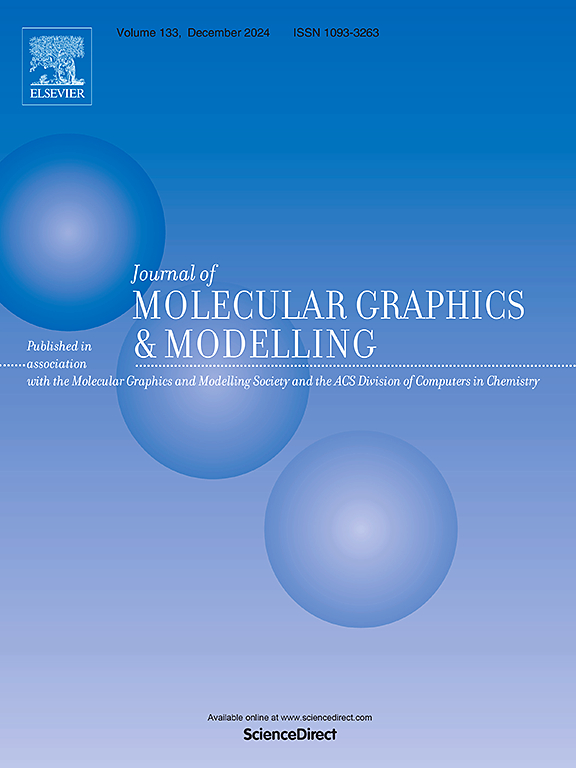Identification and investigation of hits targeting the N-methyl-D-aspartate receptor via drug repurposing: A plausible approach for anti-Alzheimer drug discovery
IF 3
4区 生物学
Q2 BIOCHEMICAL RESEARCH METHODS
引用次数: 0
Abstract
The effective treatment of neurological diseases, particularly Alzheimer's disease (AD), is a significant source of frustration for drug discovery scientists. The lengthy process of drug discovery further makes this task exceedingly challenging. To enable a rapid stride in drug discovery, we focused on the drug repurposing strategy to identify new N-methyl-D-aspartate receptor (NMDAR) inhibitors from the pool of 1827 approved USFDA drugs. The high throughput virtual screening (HTVS) followed by molecular docking and molecular mechanics studies enabled us to identify two drugs, Ertugliflozin (Dock Score: −9.43 kcal/mol, MMGBSA: −104.50 kcal/mol) and Selpercatinib (Dock Score: 8.11 kcal/mol, MMGBSA: 83.62 kcal/mol), with a high affinity towards the NMDAR. The molecular dynamics analysis on these identified drugs led us to choose Ertugliflozin for its better stability as a lead for further studies. The corroboration of in silico findings led us to deduce that Ertugliflozin can inhibit NMDAR with an IC50 of 613.19 nM. These results were confirmed by the anti-NMDAR ELISA-based analysis, which was further deduced via western blotting. The work is further supported by strong literature evidence that concludes the impact of antidiabetic molecules on AD progression, along with the evidence that Ertugliflozin possesses efficacy against AD with unequivocal evidence on the biological target and the mechanism. Further work, however, is required to establish this association in the in vivo or suitable model that could mimic the AD microenvironment as a part of future research.

通过药物再利用鉴定和研究针对n -甲基- d -天冬氨酸受体的击中:一种抗阿尔茨海默病药物发现的可行方法
神经系统疾病,特别是阿尔茨海默病(AD)的有效治疗,是药物发现科学家的一个重要挫折来源。药物发现的漫长过程进一步使这项任务极具挑战性。为了加快药物发现的步伐,我们专注于药物再利用策略,从1827种美国fda批准的药物中鉴定出新的n -甲基- d -天冬氨酸受体(NMDAR)抑制剂。通过高通量虚拟筛选(HTVS)、分子对接和分子力学研究,我们鉴定出了两种与NMDAR具有高亲和力的药物,ertuglilozin (Dock Score:−9.43 kcal/mol, MMGBSA:−104.50 kcal/mol)和Selpercatinib (Dock Score: 8.11 kcal/mol, MMGBSA: 83.62 kcal/mol)。通过对这些已鉴定药物的分子动力学分析,我们选择了稳定性较好的埃图格列净作为进一步研究的先导药物。结果表明,ertuglilozin对NMDAR有抑制作用,IC50为613.19 nM。这些结果通过基于抗nmdar的elisa分析得到证实,并通过western blotting进一步推断。强有力的文献证据进一步支持了这项工作,结论是抗糖尿病分子对AD进展的影响,以及ertuglilozin在生物学靶点和机制方面具有明确的抗AD疗效的证据。然而,需要进一步的工作来在体内或合适的模型中建立这种关联,以模拟AD微环境,作为未来研究的一部分。
本文章由计算机程序翻译,如有差异,请以英文原文为准。
求助全文
约1分钟内获得全文
求助全文
来源期刊

Journal of molecular graphics & modelling
生物-计算机:跨学科应用
CiteScore
5.50
自引率
6.90%
发文量
216
审稿时长
35 days
期刊介绍:
The Journal of Molecular Graphics and Modelling is devoted to the publication of papers on the uses of computers in theoretical investigations of molecular structure, function, interaction, and design. The scope of the journal includes all aspects of molecular modeling and computational chemistry, including, for instance, the study of molecular shape and properties, molecular simulations, protein and polymer engineering, drug design, materials design, structure-activity and structure-property relationships, database mining, and compound library design.
As a primary research journal, JMGM seeks to bring new knowledge to the attention of our readers. As such, submissions to the journal need to not only report results, but must draw conclusions and explore implications of the work presented. Authors are strongly encouraged to bear this in mind when preparing manuscripts. Routine applications of standard modelling approaches, providing only very limited new scientific insight, will not meet our criteria for publication. Reproducibility of reported calculations is an important issue. Wherever possible, we urge authors to enhance their papers with Supplementary Data, for example, in QSAR studies machine-readable versions of molecular datasets or in the development of new force-field parameters versions of the topology and force field parameter files. Routine applications of existing methods that do not lead to genuinely new insight will not be considered.
 求助内容:
求助内容: 应助结果提醒方式:
应助结果提醒方式:


